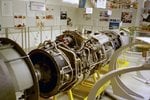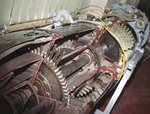kool kitty89
Senior Master Sergeant
I agree about the exaust section of the model, the struts look way off.
At least in alt the images I've seen of the 004B's exhaust there are 6 struts and they taper straight back (not curved like in the CGI immage) and are shorter inlength (how far they extend down the exhaust front-back wise).
see: http://www.enginehistory.org/German/Me-262/Me262_Engine_2.pdf (pg 32 and 36)
And a cut-away of the exhaust:

At least in alt the images I've seen of the 004B's exhaust there are 6 struts and they taper straight back (not curved like in the CGI immage) and are shorter inlength (how far they extend down the exhaust front-back wise).
see: http://www.enginehistory.org/German/Me-262/Me262_Engine_2.pdf (pg 32 and 36)
And a cut-away of the exhaust:







